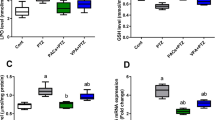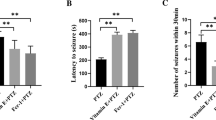Abstract
It has been widely suggested that oxidative stress products play an important role in the pathophysiology of epilepsy. Capparis ovata (C. ovata) may useful treatment of epilepsy because it contains antioxidant flavonoids. The current study was designed to determine the effects of C. ovata on lipid peroxidation, antioxidant levels and electroencephalography (EEG) records in pentylentetrazol (PTZ)-induced epileptic rats. Thirty-two rats were randomly divided into four groups. First group was used as control although second group was PTZ group. Oral 100 and 200 mg/kg C. ovata were given to rats constituting the third and fourth groups for 7 days before PTZ administration. Second, third and forth groups received 60 mg/kg PTZ for induction of epilepsy. Three hours after administration of PTZ, EEG records, brain cortex and blood samples were taken all groups. The lipid peroxidation levels of the brain cortex, number of spikes and epileptiform discharges of EEG were higher in PTZ group than in control and C. ovata group whereas they were decreased by C. ovata administration. Vitamin A, vitamin C, vitamin E and β-carotene concentrations of brain cortex and latency to first spike of EEG were decreased by the PTZ administration although the brain cortex and plasma vitamin concentrations, and brain cortex and erythrocyte glutathione and glutathione peroxidase values were increased in PTZ + 100 and PTZ + 200 mg C. ovata groups. In conclusion, C. ovata administration caused protection against the PTZ-induced brain oxidative toxicity by inhibiting free radical and epileptic seizures, and supporting antioxidant redox system.


Similar content being viewed by others
Abbreviations
- GSH:
-
Glutathione
- GSH-Px:
-
Glutathione peroxidase
- MDA:
-
Malondialdehyde
- NO:
-
Nitric oxide
- PTZ:
-
Pentylentetrazol
- ROS:
-
Reactive oxygen species
- SOD:
-
Superoxide dismutase
- EEG:
-
Electroencephalography
References
Tlili N, Elfalleh W, Saadaoui E, Khaldi A, Triki S, Nasri N (2011) The caper (Capparis L.): ethnopharmacology, phytochemical and pharmacological properties. Fitoterapia 82:93–101
Conforti F, Marcotullio MC, Menichini F, Statti GA, Vannutelli L, Burini G, Menichini F, Curini M (2011) The influence of collection zone on glucosinolates, polyphenols and flavonoids contents and biological profiles of Capparis sicula ssp. sicula. Food Sci Technol Int 17:87–97
Matthäus B, Ozcan M (2005) Glucosinolates and fatty acid, sterol, and tocopherol composition of seed oils from Capparis spinosa Var. spinosa and Capparis ovate Desf. Var. canescens (Coss.) Heywood. J Agric Food Chem 53:7136–7141
Siracusa L, Kulisic-Bilusic T, Politeo O, Krause I, Dejanovic B, Ruberto G (2011) Phenolic composition and antioxidant activity of aqueous infusions from Capparis spinosa L. and Crithmum maritimum L. before and after submission to a two-step in vitro digestion model. J Agric Food Chem 59:12453–12459
Arslan R, Bektas N (2010) Antinociceptive effect of methanol extract of Capparis ovata in mice. Pharm Biol 48:1185–1190
Tlili N, Khaldi A, Triki S, Munné-Bosch S (2010) Phenolic compounds and vitamin antioxidants of caper (Capparis spinosa). Plant Foods Hum Nutr 65:260–265
Yang T, Wang C, Liu H, Chou G, Cheng X, Wang Z (2010) A new antioxidant compound from Capparis spinosa. Pharm Biol 48:589–594
Nazıroglu M (2009) Role of selenium on calcium signaling and oxidative stress-induced molecular pathways in epilepsy. Neurochem Res 34:2181–2191
Nazıroğlu M, Kutluhan S, Uğuz AC, Celik O, Bal R, Butterworth PJ (2009) Topiramate and vitamin E modulate the electroencephalographic records, brain microsomal and blood antioxidant redox system in pentylentetrazol-induced seizure of rats. J Membr Biol 229:131–140
Nazıroğlu M, Kutluhan S, Yilmaz M (2008) Selenium and topiramate modulates brain microsomal oxidative stress values, Ca2+-ATPase activity, and EEG records in pentylentetrazol-induced seizures in rats. J Membr Biol 225:39–49
Kutluhan S, Naziroğlu M, Celik O, Yilmaz M (2009) Effects of selenium and topiramate on lipid peroxidation and antioxidant vitamin levels in blood of pentylentetrazol-induced epileptic rats. Biol Trace Elem Res 129:181–189
Swamy M, Yusof WR, Sirajudeen KN, Mustapha Z, Govindasamy C (2011) Decreased glutamine synthetase, increased citrulline-nitric oxide cycle activities, and oxidative stress in different regions of brain in epilepsy rat model. J Physiol Biochem 67:105–113
Ezz HS, Khadrawy YA, Noor NA (2011) The neuroprotective effect of curcumin and Nigella sativa oil against oxidative stress in the pilocarpine model of epilepsy: a comparison with valproate. Neurochem Res 36:2195–2204
Júnior JS, de Almeida AA, Tomé Ada R, Citó AM, Saffi J, de Freitas RM (2011) Evaluation of possible antioxidant and anticonvulsant effects of the ethyl acetate fraction from Platonia insignis Mart. (Bacuri) on epilepsy models. Epilepsy Behav 22:678–684
Xu K, Stringer JL (2008) Antioxidants and free radical scavengers do not consistently delay seizure onset in animal models of acute seizures. Epilepsy Behav 13:77–82
Akyol O, Herken H, Uz E, Fadillioglu E, Unal S, Sogut S, Ozyurt H, Savas HA (2002) The indices of endogenous oxidative and antioxidative processes in plasma from schizophrenic patients. The possible role of oxidant/antioxidant imbalance. Prog Neuropsychopharmacol Biol Psychiatry 26:995–1005
Naziroğlu M, Kutluhan S, Yilmaz M (2008) Selenium and topiramate modulates brain microsomal oxidative stress values, Ca2+-ATPase activity, and EEG records in pentylentetrazol-induced seizures in rats. J Membr Biol 225:39–49
Placer ZA, Cushman L, Johnson BC (1966) Estimation of products of lipid peroxidation (malonyl dialdehyde) in biological fluids. Anal Biochem 16:359–364
Sedlak J, Lindsay RH (1968) Estimation of total, protein-bound, and nonprotein sulfhydryl groups in tissue with Ellman’s reagent. Anal Biochem 25:192–205
Lawrence RA, Burk RF (1976) Glutathione peroxidase activity in selenium-deficient rat liver. Biochem Biophys Res Commun 71:952–958
Lowry OH, Rosebrough NJ, Farr AL et al (1951) Protein measurement with the Folin phenol reagent. J Biol Chem 193:265–275
Desai ID (1984) Vitamin E analysis methods for animal tissues. Methods Enzymol 105:138–147
Suzuki J, Katoh N (1990) A simple and cheap method for measuring vitamin A in cattle using only a spectrophotometer. Jpn J Vet Sci 52:1282–1284
Jagota SK, Dani HM (1982) A new colorimetric technique for the estimation of vitamin C using Folin phenol reagent. Anal Biochem 127:178–182
Kharatishvili I, Immonen R, Gröhn O, Pitkänen A (2007) Quantitative diffusion MRI of hippocampus as a surrogate marker for post-traumatic epileptogenesis. Brain 130:3155–3168
Kubera M, Budziszewska B, Jaworska-Feil L, Basta-Kaim A, Leśkiewicz M, Tetich M, Maes M, Kenis G, Marciniak A, Czuczwar SJ, Jagła G, Nowak W, Lasoń W (2004) Effect of topiramate on the kainate-induced status epilepticus, lipid peroxidation and immunoreactivity of rats. Pol J Pharmacol 56:553–561
Deniz Onay B, Tasdemir E, Tümer C, Bilgin HM, Atmaca M (2008) Dose dependent effects of ghrelin on pentylenetetrazole-induced oxidative stress in a rat seizure model. Peptides 29:448–455
Yegin A, Akbas SH, Ozben T, Korgun DK (2002) Secretory phospholipase A2 and phospholipids in neural membranes in an experimental epilepsy model. Acta Neurol Scand 106:258–262
Collins MA, Neafsey EJ (2012) Neuroinflammatory pathways in binge alcohol-induced neuronal degeneration: oxidative stress cascade involving aquaporin, brain edema, and phospholipase A2 activation. Neurotox Res 21:70–78
Goyal R, Grewal RB (2003) The influence of teent (Capparis decidua) on human plasma triglycerides, total lipids and phospholipids. Nutr Health 17:71–76
Zaidi SM, Banu N (2004) Antioxidant potential of vitamins A, E and C in modulating oxidative stress in rat brain. Clin Chim Acta 340:229–233
Nazıroğlu M (2007) New molecular mechanisms on the activation of TRPM2 channels by oxidative stress and ADP-ribose. Neurochem Res 32:1990–2001
Frei B, England L, Ames BN (1989) Ascorbate is an outstanding antioxidant in human blood plasma. Proc Natl Acad Sci USA 86:6377–6381
Cimen MY (2008) Free radical metabolism in human erythrocytes. Clin Chim Acta 390:1–11
Nazıroğlu M, Dikici DM, Dursun S (2012) Role of oxidative stress and Ca2+ signaling on molecular pathways of neuropathic pain in diabetes: focus on TRP channels. Neurochem Res 37:2065–2075
Nazıroğlu M (2012) Molecular role of catalase on oxidative stress-induced Ca(2+) signaling and TRP cation channel activation in nervous system. J Recept Signal Transduct Res. 32:134–141
Zia-Ul-Haq M, Cavar S, Qayum M, Imran I, de Feo V (2011) Compositional studies: antioxidant and antidiabetic activities of Capparis decidua (Forsk.) Edgew. Int J Mol Sci 12:8846–8861
Ishola IO, Adeyemi OO, Agbaje EO, Tota S, Shukla R (2013) Combretum mucronatum and Capparis thonningii prevent scopolamine-induced memory deficit in mice. Pharm Biol Pharm Biol 51:49–57
Ilhan A, Gurel A, Armutcu F, Kamisli S, Iraz M (2005) Antiepileptogenic and antioxidant effects of Nigella sativa oil against pentylenetetrazol-induced kindling in mice. Neuropharmacology 49:456–464
Nazıroğlu M, Kozlu S, Yorgancıgil E, Uğuz AC, Karakuş K (2013) Rose oil (from Rosa × damascena Mill.) vapor attenuates depression-induced oxidative toxicity in rat brain. J Nat Med 67:152–158
Zou YP, Lu YH, Wei DZ (2010) Protective effects of a flavonoid-rich extract of Hypericum perforatum L. against hydrogen peroxide-induced apoptosis in PC12 cells. Phytother Res 24(Suppl 1):S6–S10
Acknowledgments
M.N. formulated the present hypothesis and was responsible for writing the report. Ö.Ç., M.B.A., M.İ.Y. and E.B. were responsible analyses the data. The study was partially supported as graduate student project by TUBITAK, Ankara, Turkey.
Conflict of interest
None.
Author information
Authors and Affiliations
Corresponding author
Rights and permissions
About this article
Cite this article
Nazıroğlu, M., Akay, M.B., Çelik, Ö. et al. Capparis ovata Modulates Brain Oxidative Toxicity and Epileptic Seizures in Pentylentetrazol-Induced Epileptic Rats. Neurochem Res 38, 780–788 (2013). https://doi.org/10.1007/s11064-013-0978-3
Received:
Revised:
Accepted:
Published:
Issue Date:
DOI: https://doi.org/10.1007/s11064-013-0978-3




